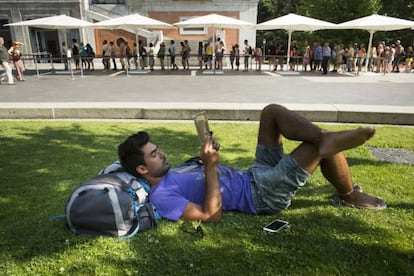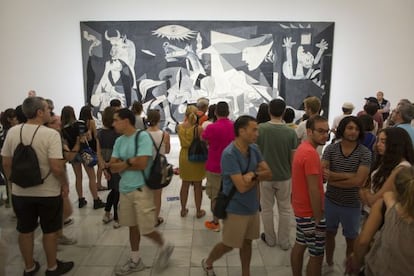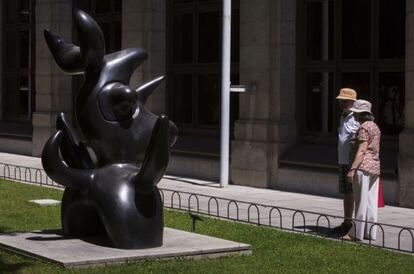Is Madrid managing to market its so-called Art Walk?
The city has been promoting the area running north from Atocha station to Cibeles Most people, however, limit their visits to galleries featuring Velázquez, Goya, and Picasso

What are the three biggest art draws for visitors to Madrid? Velázquez, Goya, and Picasso – three Spanish painters who exercise an enduring hold on the imaginations of tourists taking in the Spanish capital, whether for cultural purposes or not.
Ask any foreign visitors in Madrid this summer what they want to see when they visit the Prado, the Reina Sofía, and the Thyssen-Bornemisza, all located within the city-designated Paseo del Arte (Art Walk), and the answer rarely varies: Las Meninas by Velázquez, pretty much anything by Goya, and Guernica, Picasso’s cubist vision of the Spanish Civil War.
The Prado, Goya, and Guernica brands are well-recognized. It is difficult for them to co-exist with any other"
Thomas Spieker, German visitor to the Thyssen-Bornemisza
These were the recurring answers given by tourists who, in keeping with their status, were not to be put off by the suffocating heat last month as they made their way up and down the Paseo del Prado and Recoletos, the axis that contains the Reina Sofía museum, the Mapfre Foundation, the National Library, the Prado museum, Caixaforum, the Thyssen-Bornemisza museum and CentroCentro.
“True, it’s even hotter in Texas than in Madrid or Toledo, where we have just come from, although back home we tend not to go out in this heat. But we just had to show the Prado to our friends,” says US national Angelica Pérez, recently returned from visiting Toledo. Standing next to her was Lois Birdnell, from Kentucky, who said her targets for the afternoon were Velázquez, Goya, and Picasso.
That’s the same three artists mentioned by Japanese tourist Yuko as she walked into the Reina Sofía Museum of Modern Art after visiting the Prado with her parents.
A group of students from California, waiting patiently under a Roy Lichtenstein sculpture, had a few other suggestions. “I was really impressed by Hieronymus Bosch,” said Bianca Hernández. “What really captured my attention was how old these places and things are, and how people identify with them,” added Hernán Martínez.

“Mexico’s culture is also very old, but very different from Spain’s. By the way, I had never heard the word caña before I came here; it’s like our tequila, right?” asked Estefany Cortés. A friend quickly intervened to explain that a caña is a small measure of beer, and thus much lower in alcohol content that a shot of tequila.
The city of Madrid has been marketing the area running north from the Atocha railway station up to Cibeles as the Paseo del Arte, or the Art Walk, along the lines of Berlin’s Island of Museums. Most people, however, still limit their visits to the galleries where Velázquez, Goya, and Picasso are to be found.
“In summer, we get more backpackers and family visits. For us this is the low season; it's very different from the business tourism we get in the fall and spring, which is our high season,” says Pablo Sastre, a guide at the Prado.
July, August, and September contribute a quarter of the total visitor numbers to the Prado. The biggest lineups form during the hours when admission is free (between 6pm and 8 pm). In the case of the Reina Sofía, that is between 7pm and 9pm, and at the Thyssen, between 12pm and 4pm on Mondays.
The Prado says that most of its visitors during the summer months are from overseas, with a recent increase from Latin America. The Reina Sofia says it sees more visitors in August.
The Paseo del Arte season ticket offers access to the Prado, the Reina Sofía, and the Thyssen for €25.60, representing a 2-percent discount, but “it is possible that a lot of visitors prefer to visit just two museums,” says a spokesman for the Prado.
Mónica Basnaldo, an Argentinean visiting Spain, says that she was planning to first take in the Prado and had yet to decide if she would do the Reina Sofía later. “It’s very hot and too much culture can be bad for you! Tomorrow I’m off to the beach,” she jokes. Sara Cohen, from Mexico, says that she will probably be leaving out the Thyssen-Bornemisza, “at least on this trip,” but will be taking in the Prado and the Reina Sofía in detail.

Cohen had never heard of the Paseo de Arte, either. Talking to visitors, the impression was that the Art Walk still has a long way to go as a brand, and that the capital’s top artistic attractions speak for themselves, to the point of eclipsing other options on offer.
German national Thomas Spieker, who lives on the Costa Brava, had heard of the Art Walk, but said that “it doesn’t work.” Standing in line behind him at the Thyssen-Bornemisza, a museum with a formidable collection but lacking the emblematic works of the Prado or Reina Sofía, Joan Fibla said he had just found out about it.
“The Prado, Goya, and Guernica brands are well-recognized," adds Spieker. "It is difficult for them to co-exist with any other. It’s like trying to promote Barcelona’s architecture without Gaudí.”
Tu suscripción se está usando en otro dispositivo
¿Quieres añadir otro usuario a tu suscripción?
Si continúas leyendo en este dispositivo, no se podrá leer en el otro.
FlechaTu suscripción se está usando en otro dispositivo y solo puedes acceder a EL PAÍS desde un dispositivo a la vez.
Si quieres compartir tu cuenta, cambia tu suscripción a la modalidad Premium, así podrás añadir otro usuario. Cada uno accederá con su propia cuenta de email, lo que os permitirá personalizar vuestra experiencia en EL PAÍS.
¿Tienes una suscripción de empresa? Accede aquí para contratar más cuentas.
En el caso de no saber quién está usando tu cuenta, te recomendamos cambiar tu contraseña aquí.
Si decides continuar compartiendo tu cuenta, este mensaje se mostrará en tu dispositivo y en el de la otra persona que está usando tu cuenta de forma indefinida, afectando a tu experiencia de lectura. Puedes consultar aquí los términos y condiciones de la suscripción digital.
Últimas noticias
Half of Scotland is in the hands of 420 property owners
How Japan is trying to avert ‘digital defeat’
The complicated life of Francesca Albanese: A rising figure in Italy but barred from every bank by Trump’s sanctions
From digital curfews to blocking apps: How technology experts protect their children online
Most viewed
- Pablo Escobar’s hippos: A serious environmental problem, 40 years on
- Why we lost the habit of sleeping in two segments and how that changed our sense of time
- Trump’s obsession with putting his name on everything is unprecedented in the United States
- Charles Dubouloz, mountaineering star, retires at 36 with a farewell tour inspired by Walter Bonatti
- The Florida Keys tourist paradise is besieged by immigration agents: ‘We’ve never seen anything like this’









































